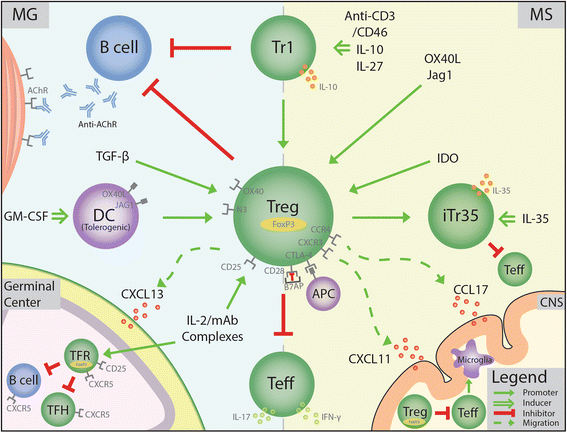Regulatory T cells in multiple sclerosis and myasthenia gravis
- PMID: 28599652
- PMCID: PMC5466736
- DOI: 10.1186/s12974-017-0892-8
Regulatory T cells in multiple sclerosis and myasthenia gravis
Abstract
Multiple sclerosis (MS) is a chronic debilitating disease of the central nervous system primarily mediated by T lymphocytes with specificity to neuronal antigens in genetically susceptible individuals. On the other hand, myasthenia gravis (MG) primarily involves destruction of the neuromuscular junction by antibodies specific to the acetylcholine receptor. Both autoimmune diseases are thought to result from loss of self-tolerance, which allows for the development and function of autoreactive lymphocytes. Although the mechanisms underlying compromised self-tolerance in these and other autoimmune diseases have not been fully elucidated, one possibility is numerical, functional, and/or migratory deficits in T regulatory cells (Tregs). Tregs are thought to play a critical role in the maintenance of peripheral immune tolerance. It is believed that Tregs function by suppressing the effector CD4+ T cell subsets that mediate autoimmune responses. Dysregulation of suppressive and migratory markers on Tregs have been linked to the pathogenesis of both MS and MG. For example, genetic abnormalities have been found in Treg suppressive markers CTLA-4 and CD25, while others have shown a decreased expression of FoxP3 and IL-10. Furthermore, elevated levels of pro-inflammatory cytokines such as IL-6, IL-17, and IFN-γ secreted by T effectors have been noted in MS and MG patients. This review provides several strategies of treatment which have been shown to be effective or are proposed as potential therapies to restore the function of various Treg subsets including Tr1, iTr35, nTregs, and iTregs. Strategies focusing on enhancing the Treg function find importance in cytokines TGF-β, IDO, interleukins 10, 27, and 35, and ligands Jagged-1 and OX40L. Likewise, strategies which affect Treg migration involve chemokines CCL17 and CXCL11. In pre-clinical animal models of experimental autoimmune encephalomyelitis (EAE) and experimental autoimmune myasthenia gravis (EAMG), several strategies have been shown to ameliorate the disease and thus appear promising for treating patients with MS or MG.
Keywords: Autoimmune disease; Dysfunction; FoxP3; Migration; Multiple sclerosis; Myasthenia gravis; Regulatory T cell; Suppression; Treg.
Figures

References
-
- Banwell B, et al. Incidence of acquired demyelination of the CNS in Canadian children. Neurology. 2009;72:232–9. doi: 10.1212/01.wnl.0000339482.84392.bd. - DOI - PubMed
Publication types
MeSH terms
Substances
Grants and funding
LinkOut - more resources
Full Text Sources
Other Literature Sources
Medical
Research Materials

